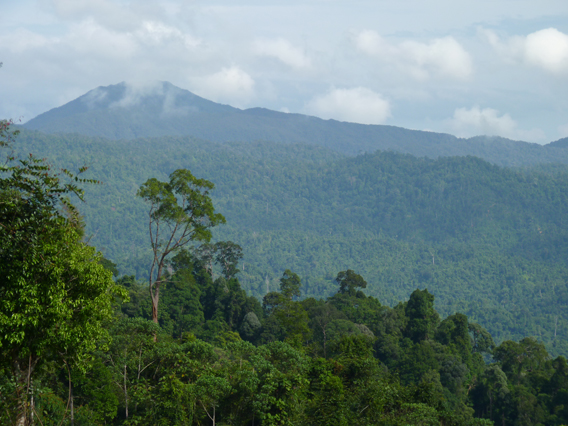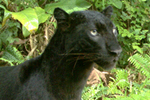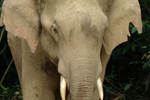
A black panther (in this case a leopard) caught on camera trap in the Kenyir Wildlife Corridor. Photo courtesy of Rimba.
The black panther has a mythical aura: Rudyard Kipling chose the animal for one of his heroes in The Jungle Book, in the 1970s it became the symbol of an African-American socialist party, while comic guru Stan Lee selected the stunning feline for his first black superhero. But the real black panther isn’t an actual species, instead it’s a rare dark pigmentation found most commonly in leopards, but also occasionally in jaguars and other wild cats. The rarity of the black panther—not to mention its striking appearance—has added to their mystery. However, recent studies have found that black panthers, in this case ‘black leopards,’ are astoundingly common in one part of the world: the Malayan peninsula.
“In the same way a genetic mutation can cause some individuals within a species to display albino characteristics, black panthers are simply individuals that have a genotype causing a uniformly black coloration on their coat,” Laurie Hedges, a carnivore researcher working with the non-profit research group Rimba, told mongabay.com in a recent interview. “In total 13 species of wild felids have been documented with ‘melanistic’ or black forms, but apart from the difference in coloration, they are still the same species as their patterned counter parts.”
Rimba, which means ‘jungle’ in Malay, is currently conducing camera trapping in two wildlife corridors in Malaysia: the Kenyir Wildlife Corridor and the Bintang Hijau Wildlife Corridors. The camera trapping research, headed by Rimba’s co-founder Gopalasamy Reuben Clements, has so far taken some astounding images and even video of the black leopard (see below). Here, black leopards are actually the dominant form of leopard. A complete reversal from what occurs across the rest of the leopard’s massive range.
 Black leopard near road in the Kenyir Wildlife Corridor. Photo by: William Yap. |
“The Malay Peninsula is entirely unique—nowhere else in the world do melanistic individuals constitute almost the entire leopard population,” says Hedges, who points to a 2010 study by Kawanishi et al in the Journal of Zoology which, “revealed that while leopards north of the Isthmus of kra between the Thai and Malay peninsula are mainly spotted, almost all records of leopards south of this famous ecological transition zone are melanistic.”
No one is entirely sure why this is the case, however it may be a combination of natural selection—i.e. black leopards survive better in this forest due to their type of camouflage—and genetics within the local population simply straying over time toward melanistic individuals.
Clements and his team are putting together a proposal to work with infrared camera traps to identify individual black leopards with the end goal of compiling a population estimate. The infrared makes the leopard’s spots, hidden beneath the dark coat, stand out in photos, allowing scientists to tell individuals apart.
“We are quite excited as, to our knowledge, this will be the first study investigating the population density of melanistic leopards in Malaysia,” says Clements who is affiliated with James Cook University and University of Malaya.
But even with its imposing presence and the mythos surrounding it, black panthers are in no way secure. Like all of the world’s great cats, leopards—whether black or spotted—face numerous perils.
“The threats to black leopards are similar to those faced by other large mammals in the area, which are mainly habitat loss and poaching,” notes Clements. “Large tracts of forests were recently cleared for a hydroelectric dam in the corridor, while poachers from Indochina still roam the forests and set snares targeting tigers.”
There has been good news recently, however, as the state government froze all development along the Kenyir Wildlife Corridor pending a government study. If Malaysia’s rainforests are preserved and anti-poaching laws enforced, this kingdom of the black panther may reign long.
AN INTERVIEW WITH LAURIE HEDGES AND GOPALASAMY REUBEN CLEMENTS

The first mammal Clements encountered in the Kenyir Wildlife Corridor was this black leopard. Photo by: Gopalasamy Reuben Clements.
Mongabay: What is the difference between a black panther and black leopard?
Laurie Hedges: The term “black panther” can actually refer to a number of different species of the felid genus Panthera such as the jaguar or leopard. In the same way a genetic mutation can cause some individuals within a species to display albino characteristics, black panthers are simply individuals that have a genotype causing a uniformly black coloration on their coat. As such, they are not considered a species. In total 13 species of wild felids have been documented with “melanistic” or black forms, but apart from the difference in coloration, they are still the same species as their patterned counter parts. The only ‘black panther’ recorded in Peninsular Malaysia so far has been the black leopard (Panthera pardus).
Mongabay: Why is the Malay Peninsula so important for black leopards?
Laurie Hedges: While melanistic individuals of leopards can be found across its range, the Malay Peninsula is entirely unique – nowhere else in the world do melanistic individuals constitute almost the entire leopard population. A study by Kawanishi et al. 2010 in the Journal of Zoology, revealed that while leopards north of the Isthmus of kra between the Thai and Malay peninsula are mainly spotted, almost all records of leopards south of this famous ecological transition zone are melanistic. However in 2010, researchers from the Wildlife Conservation Society and Panthera recorded a spotted leopard on their camera traps down in the southernmost state of Johor! So the Malay Peninsula is a really exciting place to study the evolutionary and genetic processes driving melanism in leopards.
Mongabay: Could you tell us how it’s possible that so many black leopards are
found in the Malay Peninsula as opposed to the usually much more
common spotted leopard?
Laurie Hedges: This has been something of a mystery. One hypothesis is that having a black coat may confer some kind of selective advantage to melanistic leopards. In Malaysia, for example, there is competition for prey between leopards and the Malayan tiger. Perhaps light conditions caused by a dense rainforest canopy allowed darker leopards to be more concealed and hence successful at hunting prey than spotted ones. Another theory is that a population crash of leopards in the region at some period may have left a few surviving individuals which, by chance, may have been black. This crash may have been caused by the super eruption of Mount Toba in Sumatra 74,000 years ago or changing sea levels. The remnant population would have created a “founder effect,” where offspring would inherit the genes of these few “founders.” Alternatively, the genetic make-up of the population could have simply ‘drifted’ by chance towards melanism, due to the isolation from other leopards north of the Isthmus. Scientists believe that a combination of natural selection and random genetic drift probably resulted in today’s prevalence of melanistic leopards in Peninsular Malaysia.
CONSERVATION OF THE BLACK LEOPARD

Infrared camera trap will allow Clements and his team to begin identifying individual black leopards. Photo courtesy of Rimba.
Mongabay: Why is the Kenyir Wildlife Corridor so important for these black leopards?
Gopalasamy Reuben Clements: We still do not know if the Kenyir Wildlife Corridor is important for black leopards because a population density estimate for this species has yet to be determined in Malaysia. Based on our camera trap surveys so far, however, we do know that the Kenyir Wildlife Corridor is important for wild cat conservation—six out of eight of Peninsular Malaysia’s wild cat species can be found here, including the black leopard.
Mongabay: How are efforts proceeding for protecting the Kenyir Wildlife Corridor?
Gopalasamy Reuben Clements: We are currently working with the Terengganu State Government to improve the protection of this corridor, which is still threatened by habitat loss and poaching. We are happy that the state government has so far been receptive to our recommendations and has stepped up its commitment to protect the state’s natural heritage. For example, the state recently froze all development along the highway bisecting the corridor after we showed them the diversity of wildlife species detected by our camera traps in Kenyir. We are also currently working with the state wildlife and forestry departments to improve the enforcement capacity of the state to deter poaching in the corridor.
Mongabay: What threats are posed to the black leopards in your study area?
Gopalasamy Reuben Clements: The threats to black leopards are similar to those faced by other large mammals in the area, which are mainly habitat loss and poaching. Large tracts of forests were recently cleared for a hydroelectric dam in the corridor, while poachers from Indochina still roam the forests and set snares targeting tigers. There is hope however as the Terengganu state government has laudably stepped up efforts to address these threats in the corridor.
Mongabay: Will you tell us about plans to study the big cats with infrared camera traps? Why infrared?
Gopalasamy Reuben Clements: We have been using infrared camera traps since 2010 to document the richness of mammals in the Kenyir Wildlife Corridor. We plan to continue our camera trapping surveys in Kenyir to provide long-term data for the Terengganu state government. Camera traps allow us to identify cat individuals with unique individual patterns such as tigers and clouded leopards. However, the uniform black coloration of the leopards makes identifying them from color photos quite impossible. As our camera traps are equipped with infrared light, the “rosette” spot patterns on their coat have become much clearer and we are now confident of identifying leopard individuals.
Mongabay: What do you hope to learn from these photos?
Gopalasamy Reuben Clements: We hope to determine population density estimates of the black leopard and other carnivore species in the Kenyir Wildlife Corridor, which can then be used as a baseline to compare with in later years. We are quite excited as, to our knowledge, this will be the first study investigating the population density of melanistic leopards in Malaysia. Ultimately, a long-term monitoring program in Kenyir would help us measure the effectiveness of our management interventions.
Mongabay: What other animals are found in the Kenyir region?
Gopalasamy Reuben Clements: To date, 43 mammal species have been recorded by our camera trap in this corridor, including 18 threatened mammal species according to the IUCN Red list. Also, at least 290 bird species have been documented in Kenyir, including 9 out 10 of Peninsular Malaysia’s hornbill species. Unfortunately, almost a quarter of the total, or 66 bird species, are threatened according to the IUCN. Finally, two species of the world’s largest flower, the Rafflesia, can be found in this corridor. The Kenyir Wildlife Corridor therefore contains a large proportion of Terengganu’s natural heritage that we want to help preserve as much as possible.

Forest and mountains in Kenyir Wildlife Corridor. Photo by: Gopalasamy Reuben Clements.
Related articles
Development halted in crucial wildlife corridor in Malaysia

(11/07/2012) Kenyir Wildlife Corridor in northeast Malaysia is teeming with wildlife: elephants, gibbons, tigers, tapirs, and even black panthers (melanistic leopards) have been recorded in the 60 kilometer (37 mile) stretch of forest. In fact, researchers have recorded over 40 mammal species (see species list below), including 15 threatened with extinction according to the IUCN Red List. When these findings were presented by scientists to the Terengganu state government action followed quickly: all development projects have been halted pending a government study.
Rare jungle cat filmed for only the second time
(12/12/2012) A biologist on vacation in Malaysian Borneo caught one of the world’s rarest cats on video for only the second time, reports the BBC.
Learning to live with elephants in Malaysia

(09/18/2012) Humans and elephants have a lot in common: both are highly intelligent, intensely social, and both are capable of having a massive impact on their local environments. Given their similarities, it might not be surprising that elephants and human have often run afoul of one another. Conflict between these two great species has probably been going on for thousands of years, but as human populations have grown dramatically, elephant populations have been crippled and forced into smaller-and-smaller pockets. No-where is this more true than in Southeast Asia.
New Malaysian snail named after late conservation mentor
(07/30/2012) Researchers have discovered a new snail, which is so unusual that it has been granted its own genus: Kenyirus. To date, the mysterious forest snail, found in Malaysia’s Kenyir Forest, is only known from its unique shell.
Saving the Arabian leopard, the world’s smallest leopard

(01/14/2013) Today most people are more likely to associate Yemen with warfare and bizarre terrorism plots rather than wildlife. But Yemen is home to a surprising diversity of animals, including a population of the world’s smallest leopard: The Arabian leopard (Panthera pardus nimr). Native to the Arabian Peninsula, the Arabian leopard is today extremely rare — less than 200 animals are thought to survive in the wild. Despite the cat’s precarious position, there is relatively little local enthusiasm to protect a species that is widely seen as a threat to livestock. Nevertheless one man in Yemen is trying to boost the value of leopard in the eyes of local people. David Stanton, an American teacher living in Yemen, had devoted his life to saving the Arabian leopard.
Lion population falls 68 percent in 50 years

(12/04/2012) African lions, one of the most iconic species on the planet, are in rapid decline. According to a new study in Biodiversity Conservation, the African lion (Panthera leo leo) population has dropped from around 100,000 animals just fifty years ago to as few as 32,000 today. The study, which used high resolution satellite imagery to study savannah ecosystems across Africa, also found that lion habitat had plunged by 75 percent.
Leopard poaching is a bigger problem in India than previously believed

(10/31/2012) A recent study conducted by wildlife trade monitoring group TRAFFIC uncovered unnerving statistics about the illegal trade of leopards (Panthera pardus) in India: at least four leopards have been poached every week for the past decade in the country. The study, entitled Illuminating the Blind Spot: A study on illegal trade in Leopard parts in India, highlights the severity of leopard poaching from 2001 to 2010, despite preventative measures established in 1972 by the Wildlife Protection Act (WLPA) that prohibit the sale of leopard parts in India.